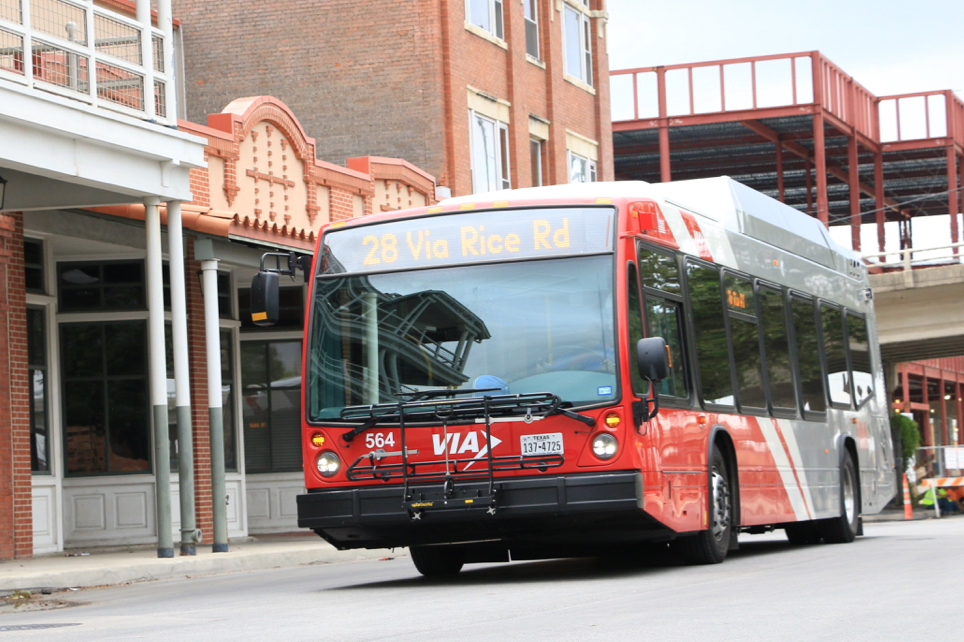Published in the San Antonio Express-News on Sept. 25, 2017
By Jeffrey C. Arndt, VIA President and CEO
Two recent events have, in very different ways, demonstrated the necessity to develop a comprehensive, multimodal transit system for our region, and elevated the conversation about the need for more and better transit options.
First, in the aftermath of Hurricane Harvey, area residents faced a run on gasoline. At one point, more than 90 percent of local gas stations were completely dry.
VIA responded by offering fare-free rides on September 5, as a service to our community and a part of our storm response contributions. We were eager to help, and our efforts created an opportunity for area residents to try transit, some for the first time. They could experience first-hand VIA’s new fleet of compressed natural gas vehicles, visit our “NextGen” bus shelters, and use VIA’s free 4G LTE WiFi—all recent, system-wide passenger amenity upgrades.
Many may have also discovered that despite these amenities, VIA bus routes lack the frequency to make public transit a desirable daily option to commuting by car. That’s because while VIA’s service area is comparable to Houston and more than double that of Dallas and Austin, VIA operates with far fewer resources than transit authorities in those cities.
VIA is the only large metro authority in Texas to operate on one-half cent sales tax. While we strive to do more with less funding, infrequent service is the result of needing to spread those resources over such a large geographic area.
Gridlock is growing, with 100 new cars added to local roadways daily, and an increase of more than 1 million new residents expected over the next two decades. Even if enough right of way existed, which it does not, we simply cannot lay enough asphalt to keep pace with this rapid growth. The focus must shift from moving cars to moving people, from a single mode to a set of attractive options for travel. In effect, we need to diversify our transportation investment portfolio.
As gas lines returned to normal, Jeff Bezos, the maverick CEO of Amazon, issued a public request for proposals for a second corporate headquarters—a project that brings with it as many as 50,000 jobs at an average annual total compensation exceeding $100,000 and $5 billion in capital investments. Included in the specifications of the RFP are requirements for direct access to mass transit, multimodal options, and a ranking of traffic congestion during peak commuting times.
The Amazon RFP effectively lays out the transit blueprint for a successful city of the future, a city built with mobility in mind and supported by efficient, attractive, diverse transportation options.
Last week, City Council took an important step toward building a transit system like Jeff Bezos describes. As part of the City’s fiscal year 2018 budget that begins October 1, Council voted to include a $4.3 million contribution to enhance VIA services. Next fiscal year, that funding proposal will increase to $10 million. The investment will allow VIA to make significant improvements to key routes and corridors that will increase the frequency and reliability for which Hurricane Harvey and Jeff Bezos helped highlight the need.
We are grateful for advocates such as San Antonio Mayor Ron Nirenberg, City Councilman Rey Saldana, City Manager Sheryl Sculley, and others in the community who are working toward solutions and recognizing the need to increase public investment in transit options.
VIA is engaged in a yearlong, publicly driven process to design the transit system that local residents want and need. To date, VIA has collected more than 1,000 public comments and nearly 4,000 surveys at workshops, community events and online. As City, County and State leaders work to find additional resources for public transit, VIA will continue to be a good steward of the resources it has while planning for the future.
Which brings us back to Amazon.
Yes, Jeff Bezos needs to know about VIA’s CNG fleet that reduces NOx emissions 97%;, its solar-powered illuminated bus stops and enhanced transit centers that provide protection for 95% of transit riders; and the fact that it was the first major transit authority in the nation to offer free WiFi across its fleet. He also needs to know that in cooperation with our public and private partners and guided by the community, VIA is moving forward with a comprehensive, multimodal transit system. That system will provide the kind of transit options Amazon seeks and that our neighbors, families, and businesses deserve.
